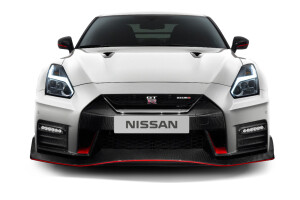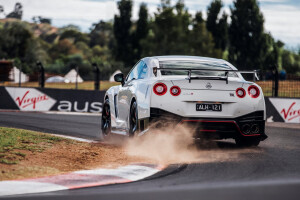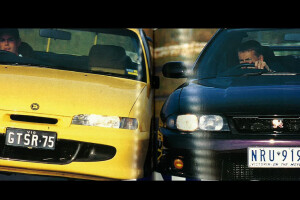Latest Review
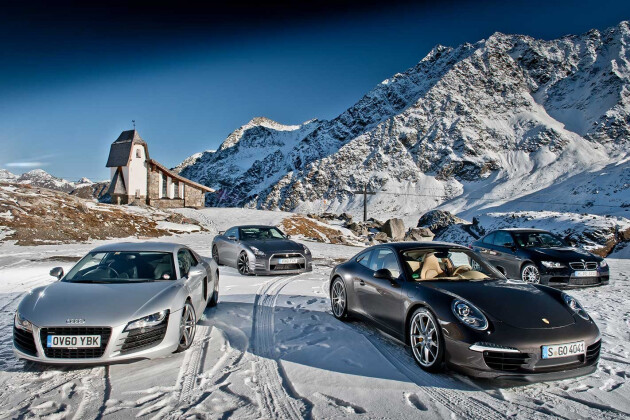
2012 Porsche 911 Carrera S vs Audi R8 vs BMW M3 vs Nissan GT-R comparison: classic MOTOR
The 991-generation 911 Carrera goes head-to-head with the world's best sportscars
It’s been the benchmark by which all sportscars have been measured against for the better part of the last 50 years, so the arrival of a new Porsche 911 is always a potentially game-changing event. But not every new 911 is as new as Porsche would like you to believe.
This feature was originally published in MOTOR’s February 2012 issue
The 997 was, for instance, a clever makeover of the not-so-desirable 996. The 991, however, has been redesigned from scratch. It boasts a brand-new longer, wider and lighter body, new interior, new electronics, new electro-hydraulic steering and the adoption of PDCC active anti-roll system.
Thankfully, what’s not new at all is the essence of the engineering concept; the trademark six-cylinder boxer engine with its slightly precarious position aft of the rear axle, the iconic coupe’s style and its elastic ability to stretch from grand tourer to mountain climber to racetrack warrior without any fuss.
The 911 isn’t alone in that domain anymore. What has changed since the last all-new 911 arrived in 1998 (the water-cooled 996) is the bredth and depth of new challengers Porsche’s icon has to contend with now.
What we’ve assembled here is a bunch of relatively old cars, but all of them have lifted the sportscar benchmark in different areas enough to put the 911 on notice. The Audi R8 hit showrooms in April 2007 (we had to wait another six months for it to hit Aussie shores) and is due for a facelift in the next few months, with the heavily revised second-generation model following suit in mid-2014.
The M3 was launched just five months later and won’t be replaced until mid-2014 either, when the next M3 swaps the normally-aspirated V8 for a twin-turbo six. Outside of Japan and the USA, the current Nissan GT-R was not available before May 2009. For model year 2012, the Japanese cult coupe received minor styling mods, a round of suspension and brake upgrades as well as a power boost from 390 to 404kW.
We put these four cars through their paces on a variety of different turfs, from autobahns to fast A- and B-roads, winding country lanes, mountain passes and even snow and ice. Although the white stuff is, this winter, an unusually rare commodity, we did find a nice mix of packed and powder high up in the Tyrolean Alps.
Even more slippery than wet pavement, the linen ground provided an ideal stage to probe the performing-under-pressure talents of our four actors. Which, in this case, range from the front-engined, rear-wheel drive M3, to the mid-engined, all-wheel drive R8, the rear-engined, rear-wheel drive 911 and the front-engined, all-wheel drive GT-R.
The list of engine configurations includes a normally-aspirated flat six and a twin-turbo V6, along with a pair of torquey atmo V8s. In terms of transmissions, three dual-clutch cogworks take on the Audi’s solitary six-speed manual. The Nissan is the heaviest at 1740kg, followed by the BMW at 1580, the Audi at 1560 and the Porsche at 1415 kilos.
At the end of our epic drive through the most picturesque parts of Austria and Bavaria, the 911 was the car everyone kept talking about. Even after six generations, the new rear-engined sportscar still has us hooked with its expressive design, the vocal and charismatic engine and the spicy handling. What has changed over time, though, is the detail execution.
On request, the steering wheel is now electronically adjustable and has chromed shift paddles attached to its backside, the clutch can be expelled in exchange for the optional PDK ’box and the available seat selection varies from ultra-comfy to carbonfibre minimalistic.
Unlike the latest 3-Series saloon which can be typecast into Sport, Modern and Luxury moulds, the M3 Coupe is still workstation-like functional. While the M3 GTS is essentially a stripped-down track-day special, the base models can be specified with all conceivable mod cons like sat-nav, heated memory seats and a high-end audio system.
Extra money buys the desirable competition pack which sharpens all major man-machine interfaces and sports a set of eye-catching alloys not pictured here – after all, our M3 ran on slimline 18-inch snow tyres. Also optional are bold carbonfibre air dams and the loud free-flow M Performance exhaust.
Most R8s are ordered with the R-tronic transmission which is, like its E-gear equivalent from Lamborghini, a hydraulically-operated manual ’box. With the facelift, this outmoded set of cogs will be replaced by a seven-speed dual-clutch S-tronic. Thankfully, the six-speed manual soldiers on in all R8 models on until the car is replaced in 2014.
One notch above the GT-R Premium Edition ranks the slightly sportier Black Edition featured here. It comes with Recaro seats, two-tone leather-Alcantara trim and charcoal alloy rims.
What often drives the transaction price of modern Porsches through the roof is not the quest for the biggest engine or the widest wheels, but a bunch of costly acronyms which manifest new standards of high technology.
Our brown beauty featured PDLS (dynamic lights), PDK (dual-clutch ’box), PCM (infotainment), PCCB (ceramic brakes), PTV (torque vectoring), PASM (active dampers) and PDCC (dynamic anti-roll system). That’s OTT by most clients’ standards, but according to 911 guru Walter Rohrl, PDCC and PCCB are nice to have on the track where a flatter ride and even more awesome deceleration can make all the difference.
Having sampled three different specimens of the 991 kind over the past few months, I tend to lean towards the notably more affordable, yet barely less capable, 257kW Carrera with 20-inch wheels and sports suspension as the only chassis-related extras. Although the 294kW Carrera S sounds, looks and performs a little better, you also get the full 911 fix with the lesser engine.
But are these innovations highly intelligent if somewhat narcissistic solo artists, or can they also work together in concert, with the driver acting as conductor? For a start, the 991 is not your father’s 911, despite the samey silhouette and familiar voice. Redlined at 7800rpm, the new engine is more free-revving and linear in character than its initially more restrained, but ultimately more explosive, forerunners.
You can now leave the gear lever in D, stab the throttle and marvel at the 3.8-litre flat six as it whips the gears through their paces, never losing more than 1000-1500rpm during upshifts. Want to really go for it? Then push Sport Plus, and the acceleration time from 0-100km/h will shrink almost physically from 4.3 to 4.1sec as revs, torque and wheelspin perform a magic jam session.
Keep the hoof down, and the car will pass the 160km/h mark still in fourth gear, storming towards the horizon as if fired by an afterburner. Porsche is posting a top speed of 304km/h, but even on a deserted autobahn we backed off at an indicated 257km/h since all cars were shod with winter tyres.
The Nissan, too, would wriggle, stomp and fight when pushed hard. On undulating ground, this car accelerates like a rocket-powered steamroller on pneumatic stilts – kicking, lurching and vaulting forward in rapid suck-and-release succession: Gorilla Godzilla on the prowl.
Only a Japanese engineer can invent a suspension which has firmer springs on the driver’s side to compensate for the offset propshaft and the weight of the driver, but that’s exactly what the 2012 model GT-R fields, along with an upward-facing left rear control arm and a downward-pointing right rear control arm. In sync, these asymmetrical hardware items are claimed to provide superior handling balance, quicker steering response and enhanced stability.
When that 404kW 3.8-litre V6 explodes, these combined kinematic wizardries effectively support the trick four-wheel drive system, the diffs that devise the torque flow and the sticky 20-inch Dunlop SP Winter Sport runflats in their quest to keep the mighty mauler on course.
In addition to the turbo whine, wastegate whistle, intake howl and exhaust thunder, every knife-between-the-teeth stampede along the ridge of adhesion is accompanied by the rhythmic rattling of the ESP and EDC solenoids. At 2.8sec from 0-100km/h, the latest GT-R is not only over half a second faster than last year’s model, it also eclipses the German sportscar establishment to a demoralizing degree.
But speed isn’t everything. Emotion matters more, and the expert stimulation of the receptive nerve ends has less to do with sheer velocity than with subtle interaction, control and response. This is the domain of the M3 which steps sideways out of bed in the morning, lets its tail hang out wide on the way to and from lunch, and finishes the day off with a donut or two on the garage forecourt.
Fitted with petite 18-inchers and same-format all-round M&S rubber, the V8-engined crackerjack took every opportunity to catch late-season insects with its side windows. Redlined at 8300rpm, the 309kW 4.0-litre V8 takes 4.8sec to lunge this coupe-on-steroids to 100km/h, and it’s a creamy, smooth and free-revving motor.
True, the M3 is quite heavy, rather thirsty and a little outmoded here and there. But it still is a true hooligan’s delight; a proper driver’s car fitted with firm yet almost telepathic steering, strong life-saving brakes and an old-world chassis that has Entertainment Tax Paid stamped all over it.
Those who can afford to upgrade from extrovert oversteer to introvert ability may end up settling for the R8. The mid-engined contender is a fine choice – unless you are very tall, in which case you may find the packaging rather cramped.
The Audi is every bit as fluent and responsive as the BMW in the way it acts and responds, but it flexes its muscles with more discipline, performs with greater precision and times its gestures with greater maturity. True, there is quattro to iron out traction issues, answer stability questions and deal with torque split conflicts. But as soon as ESP takes a break, the law of physics invariably takes over.
The steering is as three-dimensional as a circular array of feelers, the chassis displays serious floor exercising talents even when hampered by relatively low-grip rubber and the four disc brakes have taken out a PhD in reverse thrust deceleration. The manual transmission may be slow and bulky, but at the end of the day it is more involving than all those modern piano shifters.
On snowy ground, the Porsche was the car everyone queued up for. With the engine perched almost on top of the driven wheels, the 991 puts the power down promptly, and although the car’s nose will occasionally struggle to adhere to the chosen line, pumping that fat rear end ’round bend after bend is a real treat.
Predictably, the M3 is almost equally talented at pleasing the child inside. The car from Munich would in fact have emerged as the uncrowned drift king, but keeping up the momentum on the progressively more polished ice rink was a real balancing act.
Although the R8 quattro scores full marks for its double axels, the Audi needs quite a bit more space to perform its extrovert sweeps. Forebear of all torque monsters, the Nissan was prone to early understeer and persistent wheelspin, and required firm throttle orders before it would wedel through the gates like a champ.
On the scenic and virtually traffic-free C-road through paradise from Zwieselstein to Vent, the boxy batmobile from Pachinko Land showed the C2S one last time where the hammer hangs. Although it distanced the Porsche and dwarfed the R8 and M3, during the debriefing at the top of the mountain everybody was raving about the 911 which spoiled us with instant feedback, 3D responses and a crystal-clear dialogue between car and driver.
Did we have an issue with the new power steering? Not really. After all, the Plus suffix does not indicate an active intervention. All one registers is a momentary minor tug which suggests that a correction manoeuvre might be appropriate.
Also gone are other traditional 911 misbehaviours, like the pumping motion of the offside rear wheel when accelerating hard out of a bend, the ho-hum high-speed aerodynamic stability, and the once notorious lift-off exit shrug which has been expertly neutralized by the two hydro-mechanical links of PTV Plus.
Efficiency may not be a key issue when you can spend a lazy 160K-plus on a Sunday morning plaything, but social acceptance is fast becoming a major buying motif, so the fuel economy does matter.
Unfortunately, this is a field where fact and fiction seldom match. Just look at the official numbers which see the Porsche (8.7L/100km, a 15 percent improvement over the 997) lead the Nissan (11.8L against 12.0L for last year’s model) by a huge margin, followed by the BMW (12.4L) and the Audi (14.2L).
In real life, however, the gap between the 911 and its rivals is less dramatic than on paper. And when you give these automobiles stick, their thirst for 95-plus octane instantly rises, even before the petrol floodgates open on an empty autobahn.
During our three-day event, the Audi (18.8L/100km) was the least economical, followed by the Nissan (16.6L), the BMW (15.7L) and the Carrera 2S (14.1L). But only the Porsche – and only when fitted with PDK – has that clever coast-on-demand feature which shifts smoothly into neutral and lets you waft along at a green 800rpm at speeds of up to 113km/h. The next step will be a plug-in hybrid, but this application is still about four years away.
Four candidates, four winners? That would be too simple and superficial. First to fall through the grid is the Audi. The R8 is, in essence, an Italian thoroughbred built in Germany, finished to German quality standards and powered by the VW group’s longest-running V8 engine.
The Audi has great presence on the road, it feels special enough inside and it delivers in a grown-up yet laid-back manner. But there are downsides, too, like weight, thirst and cost, plus a rather tight cabin which will, unfortunately, be transplanted into the next-generation car. Here and now, the best R8 buy is perhaps a used one.
Exactly the same applies to the M3. With the replacement model waiting around the corner, it takes a rich M aficionado to shell out over $160,000 for an all-in factory-fresh Coupe when you can snap up a barely run in four-door saloon for much less.
The BMW does promise plenty of old-fashioned fun: massive V8 grunt, fearless brakes, meaty steering and gummed chassis make it a great Sunday morning rebel. But in the end, the M3 is a 3-Series Coupe on steroids, and even in full ecstasy trim, it can’t quite match the pace of the competition.
So, GT-R or Carrera 2S? Wait a minute. Let’s zoom in for a moment on the aforementioned base 911, and let’s be conservative with the options.
You see, Carrera and Carrera S are only separated by nuances in talent but by five figures in asking price. Great as it was to sample all the latest trickeries of the Weissach R&D wizards, it must be said that the 991 is also highly desirable in no-frills form.
Shelling out $229K for a 911 that is not a turbo seems like an act of over-indulgence … which is another way of saying that for the same money nothing beats the GT-R.
True, the PlayStation design is beginning to age, the interior does not look or feel truly special, and the build quality lacks the typical Teutonic finesse. But try to name a more ballistic A-to-B racer, a rival which releases similar quantities of adrenaline, or a more complete 24/7 near-supercar.
The Nissan competes in a different power and performance class. It could even challenge the 911 turbo. It invariably arrives a cigarette-length before the rest of the pack, and it should win. But it doesn’t. Because the bumblebees inside the tummy hand victory to the Porsche.
Mr Lightfoot is as trustworthy as a warm handshake, as sensitive as a soft caress and as determined as a firm embrace. Its talents go deeper, spread wider and last longer. It feels more like an old mate than a failsafe high-precision tool.
More important still, the 991 is a proper, died-in-the-wool 911. By a wafer-thin margin, it snatches the trophy away from the GT-R – at least for those who prefer a wide spectrum of competence over the focused ability to beat just about any street-legal four-seater against the stopwatch.
Fast Facts
| BMW M3 | Nissan GT-R | Audi R8 | Porsche 911 Carrera S | |
| Body | 2-door, 4-seat coupe | 2-door, 2-seat coupe | 2-door, 4-seat coupe | |
| Drive | rear-wheel | all-wheel | rear-wheel | |
| Engine | 3999cc V8, DOHC, 32v | 3799cc V6, DOHC, 24v, twin-turbos | 4163cc V8, DOHC, 32v | 3800cc flat-6, DOHC, 24v |
| Bore x Stroke | 92.0 x 75.2mm | 95.5 x 88.4mm | 84.5 x 92.8mm | 102.0 x 77.5mm |
| Compression | 12.0:1 | 9.0:1 | 12.5:1 | |
| Power | 309kW @ 8300rpm | 404kW @ 6400rpm | 309kW @ 7800rpm | 294kW @ 7400rpm |
| Torque | 400Nm @ 3900rpm | 632Nm @ 3200-5800rpm | 430Nm @ 4500-6000rpm | 440Nm @ 5600rpm |
| Power/Weight | 195kW/tonne | 232kW/tonne | 198kW/tonne | 208kW/tonne |
| Transmission | 7-speed dual-clutch | 6-speed dual-clutch | 6-speed manual | 7-speed manual |
| Weight | 1580kg | 1740kg | 1560kg | 1415kg |
| Suspension (f) | struts, A-arms, adaptive dampers, anti-roll bar | double A-arms, coil springs, adaptive dampers, anti-roll bar | struts, A-arms, adaptive dampers, anti-roll bar | |
| Suspension (r) | multi-links, coil springs, adaptive dampers anti-roll bar | double A-arms, coil springs, adaptive dampers, anti-roll bar | multi-links, coil springs, adaptive dampers, anti-roll bar | |
| L/W/h | 4615/1842/1345mm | 4650/1895/1370mm | 4431/1904/1252mm | 4491/1808/1295mm |
| Wheelbase | 2761mm | 2780mm | 2650mm | 2450mm |
| Tracks | 1540/1539mm (f/r) | 1590/1600mm (f/r) | 1632/1593mm (f/r) | 1538/1516mm (f/r) |
| Steering | power rack and pinion | electrically assisted rack-and-pinion | ||
| Brakes (f) | 360mm ventilated/drilled discs, single-piston calipers | 390mm ventilated/drilled discs, six-piston calipers | 381mm ventilated/drilled discs, eight-piston calipers | 340mm ventilated/drilled discs, six-piston calipers |
| Brakes (r) | 350mm ventilated/drilled discs, single-piston calipers | 380mm ventilated/drilled discs, four-piston calipers | 356mm ventilated/drilled discs, four-piston calipers | 330mm ventilated/drilled discs, four-piston calipers |
| Wheels | 19 x 8.5-inch (f), 19 x 9.5-inch (r) | 20 x 9.5-inch (f), 20 x 10.5-inch (r) | 19 x 8.5-inch (f), 19 x 11.0-inch (r) | 20 x 8.5-inch (f), 20 x 11.0-inch (r) |
| Tyre Sizes | 245/35ZR19 93Y (f), 265/35 ZR19 97Y (r) | 255/40ZRF20 97Y (f), 285/35ZRF20 100Y (r) | 235/35ZR19 91Y (f/r) | 245/35ZR20 (f), 295/30 ZR20 (r) |
| Tyres | Michelin Pilot Sport | Dunlop SP Sport Maxx GT 600 DSST CTT | Pirelli P Zero Corsa | Michelin Pilot Sport |
| Price | $162,300 | $168,800 | $271,500 | $263,100 |
| Pros | Massive grunt, brilliant stoppers, fun chassis | More grunt, grip and go for what was already an absolute weapon | Supremely capable all-round sportscar, real road presence | Improved cabin, control, quality, looks and high-tech goodies |
| Cons | Basic 3-series origins showing its age, thirsty | Techno overkill, PlayStation interior, still a hefty bugger | Heavy, thirsty, pricey and still has that tight-squeeze cabin | Pricey, doesn’t have the outright grunt of the GT-R |
| Rating | 9 out of 10 stars | 9 out of 10 stars | 9 out of 10 stars | 9.5 out of 10 stars |
News
-
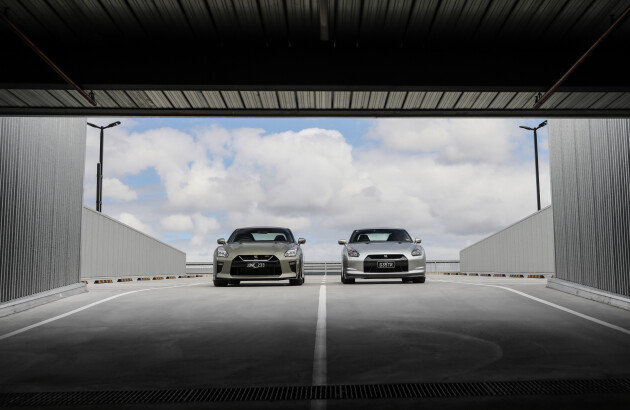 Features
FeaturesFarewell drive: R35 Nissan GT-R, first and final forms
As the sun sets on Nissan’s R35 GT-R in Australia, we give it one last meal – a bowl of bitumen spaghetti, its favourite – and reflect on the impact it made
-
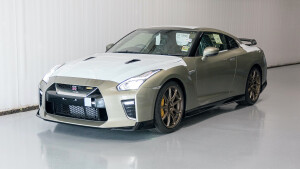 News
NewsRare 2021 Nissan R35 GT-R T-Spec offered at auction for a good cause
What may be the last R35 GT-R to have been delivered in Australia heads to auction, with part of the proceeds going to charity
-
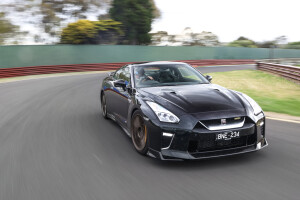 News
NewsNissan GT-R discontinued in Europe due to noise regulations
Godzilla's reign is coming to an end
-
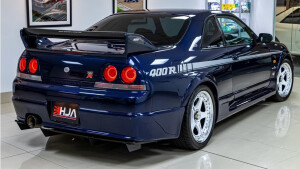 News
News1998 Nissan R33 Skyline GT-R Nismo 400R offered for $3 million
One of the rarest Japanese performance cars is up for sale, with one of the highest prices
-
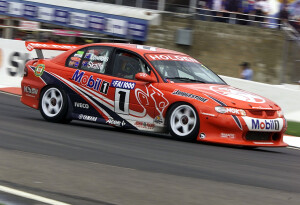
The 10 greatest touring cars of all time
-
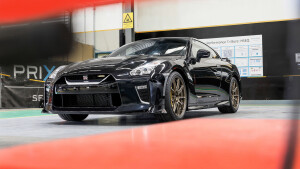
First 2022 Nissan GT-R T-Spec fitted with final compliance label
-

2023 Nissan GT-R R36 hybrid theory gaining traction
-
Why Nissan’s use of Millennium Jade on the GT-R is telling


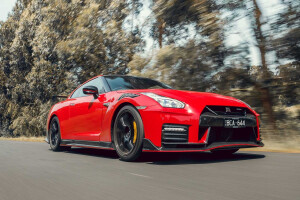
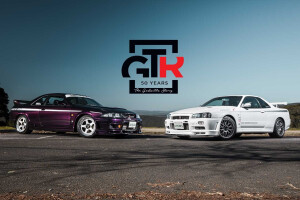
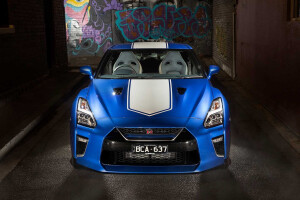

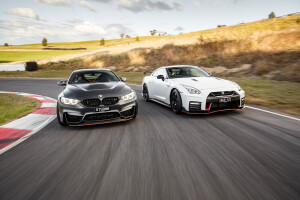
.jpg)
